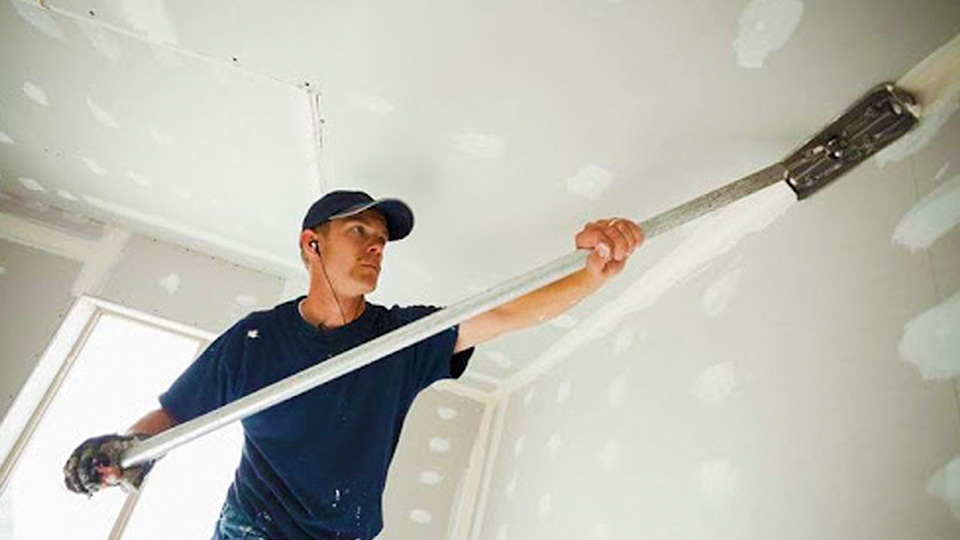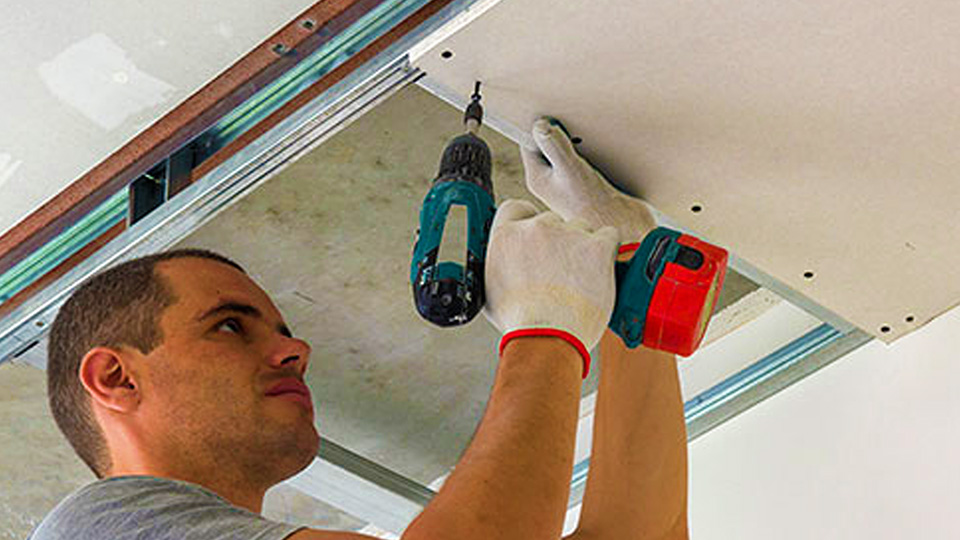Need Drywall Repair in Vancouver to Abbotsford – Click Here >
Ceiling Texture Removal and Repair >
Textured Ceiling Crack Repair >
Popcorn Ceiling Repair and Repainting >
Textured ceilings, often referred to as “popcorn ceilings,” were a popular design choice from the 1950s to the 1980s. They are known for their distinctive bumpy appearance, which can help hide imperfections and muffle sound. However, over time, these ceilings can develop cracks, holes, or other damage that requires repair. This guide will address common questions about textured ceiling repair and provide tips for patching, painting, and maintaining these unique ceilings.
Can You Patch a Textured Ceiling?
Yes, you can patch a textured ceiling. The process involves assessing the type of texture used, choosing the appropriate patching materials, and matching the texture to create a seamless repair. The key is to ensure that the patched area blends with the surrounding ceiling.
How Do You Fix a Popcorn Ceiling Patch?
Fixing a popcorn ceiling patch involves several steps:
Identify the Damage: Examine the extent of the damage. If it’s a small hole or crack, a simple patch may suffice. Larger areas may require additional support, like drywall backing.
Clean the Area: Remove any loose debris or dust from the damaged area. A vacuum cleaner or a soft brush can help with this.
Apply the Patch: For small holes or cracks, use a lightweight spackle or joint compound to fill the void. For larger areas, you might need to install a drywall patch.
Match the Texture: This is the trickiest part. Use a texture spray or a sponge to recreate the popcorn effect. Experiment on a scrap piece of drywall to get the right texture.
Sand and Paint: Once the patch is dry, lightly sand the area to smooth out any rough edges. Then, paint the patched area to match the rest of the ceiling.
Can You Patch Repair a Ceiling?
Yes, you can patch repair a ceiling. The technique varies depending on the type of ceiling and the extent of the damage. For drywall ceilings, use joint compound and a patch kit. For plaster ceilings, you might need a specialized plaster repair kit. In either case, the key is to ensure the patch is secure and blends with the rest of the ceiling.
How Do You Tape a Textured Ceiling?
Taping a textured ceiling can be challenging due to the uneven surface. However, it is possible with the right approach:
Choose the Right Tape: Use a high-quality painter’s tape designed for textured surfaces.
Press Firmly: When applying the tape, press it firmly into the texture to ensure a good seal. Use a putty knife or similar tool to smooth out the tape.
Remove Carefully: When removing the tape, do so slowly and at an angle to avoid damaging the texture.
Can You Use Painter’s Tape on Textured Ceiling?
Yes, you can use painter’s tape on a textured ceiling, but it requires careful application. Choose a tape designed for textured surfaces and press it firmly to ensure a good seal. If applied correctly, painter’s tape can help create clean lines for painting or repair work.
How Can I Cover a Textured Ceiling Without Removing It?
There are several ways to cover a textured ceiling without removing it:
Drop Ceiling: Installing a drop ceiling is a popular option. It involves suspending a grid system below the existing ceiling and adding ceiling tiles.
Plasterboard or Drywall: You can cover the textured ceiling with a new layer of plasterboard or drywall. This creates a smooth surface without removing the existing ceiling.
Wood Paneling: Adding wood paneling or shiplap can create a unique aesthetic while covering the textured ceiling.
Stretch Fabric: This involves stretching fabric across a frame to create a smooth surface. It’s a less common method but can be effective.
How Do You Fix a Small Hole in a Textured Ceiling?
To fix a small hole in a textured ceiling, follow these steps:
Clean the Area: Remove any loose debris or dust.
Apply Spackle or Joint Compound: Use a lightweight spackle or joint compound to fill the hole. Smooth it out with a putty knife.
Match the Texture: Use a texture spray or sponge to recreate the popcorn effect.
Sand and Paint: Once dry, lightly sand and paint the patched area to match the rest of the ceiling.
What is the Best Filler for Ceiling Patch?
The best filler for ceiling patch depends on the type of ceiling. For drywall ceilings, lightweight spackle or joint compound works well. For plaster ceilings, use a plaster repair kit. When patching a textured ceiling, ensure the filler is compatible with the texture spray or other texturing techniques.
Can You Spot Repair Popcorn Ceiling?
Yes, you can spot repair a popcorn ceiling. The key is to match the texture as closely as possible. Use a texture spray or sponge to recreate the popcorn effect. Test the texture on a scrap piece of drywall before applying it to the ceiling. Spot repairs should blend seamlessly with the rest of the ceiling.
How Do You Fix a Popcorn Ceiling Cheaply?
To fix a popcorn ceiling cheaply, consider the following tips:
DIY Repairs: By doing the repair work yourself, you can save on labor costs. Use readily available materials like joint compound, spackle, and texture spray.
Patch Small Areas: If the damage is localized, patch only the affected area instead of replacing the entire ceiling.
Use Texture Spray: Texture spray is a cost-effective way to match the popcorn texture without specialized tools.
Repaint: A fresh coat of paint can help blend the patched area with the rest of the ceiling, giving it a uniform look.
How Do You Use Ceiling Texture Spray?
Using ceiling texture spray requires careful application:
Shake Well: Shake the can thoroughly to ensure even distribution of the texture material.
Test on Scrap Material: Before applying to the ceiling, test the spray on a scrap piece of drywall to get the right texture.
Apply Evenly: Hold the can about 12-18 inches away from the surface and spray in a sweeping motion. Avoid oversaturating the area.
Allow to Dry: Give the texture ample time to dry before touching or painting it.
Are Textured Ceilings Dated?
Textured ceilings can be considered dated, especially the popcorn style popular in the mid-20th century. However, they can still be functional and aesthetically pleasing if well-maintained. Some people choose to update their ceilings by smoothing them out or adding modern textures. Ultimately, whether textured ceilings are dated depends on personal preference and current design trends.
How Do You Fix Textured Walls and Ceilings?
Fixing textured walls and ceilings involves similar techniques:
Identify the Damage: Determine if it’s a hole, crack, or other issue.
Clean the Area: Remove any loose debris or dust.
Apply Patch Material: Use joint compound or spackle for small repairs. For larger repairs, use drywall patches or plaster repair kits.
Match the Texture: Use texture spray or sponges to recreate the desired texture.
Sand and Paint: Once the repair is dry, sand lightly and paint to match the surrounding area.
Why Do Textured Ceilings Crack?
Textured ceilings can crack for several reasons:
- Structural Movement: Changes in the building’s structure due to settling or temperature fluctuations can cause cracks.
- Moisture: High humidity or water leaks can weaken the ceiling, leading to cracks.
- Age: Over time, textured ceilings can degrade and develop cracks.
Why Do Old Houses Have Textured Ceilings?
Old houses often have textured ceilings because they were a popular design choice in the past. Textured ceilings were used to hide imperfections in construction and muffle sound. They were also relatively easy to apply compared to other ceiling finishes.
How Do You Fix a Large Crack in a Popcorn Ceiling?
To fix a large crack in a popcorn ceiling, follow these steps:
Assess the Crack: Determine the extent of the crack and whether it requires additional support.
Clean the Area: Remove any loose debris or dust.
Reinforce if Needed: If the crack is large, you might need to add drywall tape or a patch to provide support.
Apply Joint Compound: Use joint compound to fill the crack and smooth it out.
Match the Texture: Use texture spray or sponge to recreate the popcorn texture.
Sand and Paint: Once dry, sand lightly and paint to match the rest of the ceiling.
How Do You Repair Cracks in Plasterboard Ceiling?
To repair cracks in plasterboard ceiling, use the following approach:
Clean the Crack: Remove any loose plaster or dust.
Reinforce with Drywall Tape: Apply drywall tape over the crack to prevent it from spreading.
Apply Joint Compound: Cover the tape with joint compound and smooth it out.
Sand and Paint: Once dry, sand the area lightly and paint to match the rest of the ceiling.
How Much Does It Cost to Smooth Out a Textured Ceiling?
The cost to smooth out a textured ceiling varies depending on the size of the ceiling and whether you hire professionals. On average, smoothing out a textured ceiling can cost between $1,000 and $3,000 for a standard-sized room. This includes labor, materials, and cleanup costs.








